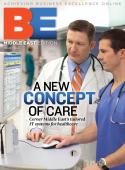Farm to forkThomas R. Cutler outlines the traceability solutions we need to deal with the increasing incidence of food contamination. The most susceptible to food-borne illness are the very young, the elderly, and people with weakened immune systems. Most people who eat food tainted with E. coli are rarely sick enough to see a doctor, so the actual number of infections may be a hundred times greater than the official counts.┬áBoston Globe correspondents Elizabeth Cooney and Neil Munshi reported that seven people in Massachusetts fell ill, (most likely) after eating beef sold at Whole Foods Market, and that the contamination is a major blow to a chain that promotes its food as superior to that in typical grocery stores, and that is already struggling in this weak economy.Meat tainted with the E. coli bacteria can cause bloody diarrhea, dehydration, and in severe cases, kidney failure. This incident is the third time in summer 2008 when consumers have feared for the safety of food products in their homes. It started in June with tomatoes suspected of being tainted with salmonella, but the cause turned out to be serrano and jalape├▒o peppers. That scare was followed by contaminated ground beef at the Kroger grocery chain.This most recent cause for food safety concern is Whole Foods supplier, Coleman Natural Beef, whose meat is processed by Nebraska Beef Ltd., (also involved in the Kroger contamination.) Despite assurances from Coleman that no product delivered to Whole Foods Market was part of the Kroger contamination, some question that assertion.Image and the bottom lineNeither for public safety or company reputations is there ever a good time for a contamination outbreak. It is an especially bad time for Whole Foods to have this type of notoriety, as customers are returning to standard grocery retailers due to a tough economy. This is more than merely a public relations challenge for Whole Foods Markets, but flies in the face of the company motto that its food products are from premium sources that are healthier and better for the consumer. The mere inference that Whole Foods Markets is connected to E. coli may severely damage the brand.Gary Nowacki, CEO of TraceGains, suggested that, ÔÇ£Technology solutions utilizing ÔÇÿpositively assured traceabilityÔÇÖ enable cross-enterprise traceability, without the participants needing to re-architect their IT infrastructureÔǪtrue farm-to-fork traceability, including all owners and handlers, and transformative processes.ÔÇØ TraceGains has specialized expertise in providing live animal-to-carcass-to-cut-to-retailer tracking.Traceability solutions must link live animals to individual meat cutsUnlike lot traceability that is mandated by the Bioterrorism Act or part of a food companyÔÇÿs HACCP (Hazard Analysis Critical Control Points), few technology solutions allow integration of available live animal data. Nowacki urges, ÔÇ£Meat processors must be able to uniquely track animals from packing plant arrival through fabrication to meat cut shipment, as well as handling individual animals or lots based upon plant size and traceability requirements.ÔÇØ┬á Other specific traceability features that meat processors must consider include:ÔÇó Tracing meat cuts and shipping boxes back to the original animal(s)ÔÇó Tracking each animal to its respective meat cuts and shipping boxesÔÇó Recording the weights of individual cuts and associating them with the individual animalÔÇó Generating a unique barcode label required for both the individual package and shipping boxÔÇó Sharing individual meat cut information with resellerÔÇó Shift-production for stock to cooler (maintain traceability from cooler to further production)ÔÇó Shift-production for process to specific orders (optimized ÔÇ£Meat Block ScheduleÔÇØ based upon truckload or lot attributes).Food safety is profitableNowacki suggested that the issue of food safety is not in opposition to increased profitability. ÔÇ£Technology solutions must provide complete animal to carcass to primal to cut to case-ready traceability at the speed of commerce at minimal cost, while economically meeting marketplace and governmental traceability requirements.ÔÇØ Indeed these solutions reduce the potential negative impact and the potential cost of recalls; speeding up response rates.┬á Beyond the image and obvious need to keep the food supply chain safe, food processors must look for actionable ÔÇ£attribute value foundationÔÇØ to increase yields, reduce costs, and drive continuous improvement. In doing so, accurate product inventory is provided.Enabling COOL (country of origin labeling) and NAIS (national animal identification system) regulatory compliance is the law. Live animal solutions create export verification program value opportunities as well as brand differentiation through verified attributes.Brand protection through source verification, meeting customer mandates for verified supply and specification product, and risk management through improved food safety and managed recalls are no longer optional, rather requirements that yield great profitability.Undoubtedly the Whole Foods contamination issue will abate as another food processor or retailer is reported. The potential financial risk to these businesses far outweighs the cost of purchasing comprehensive traceability technology. The ability to regain public trust is questionable. Saving livesÔǪ.priceless.┬á









